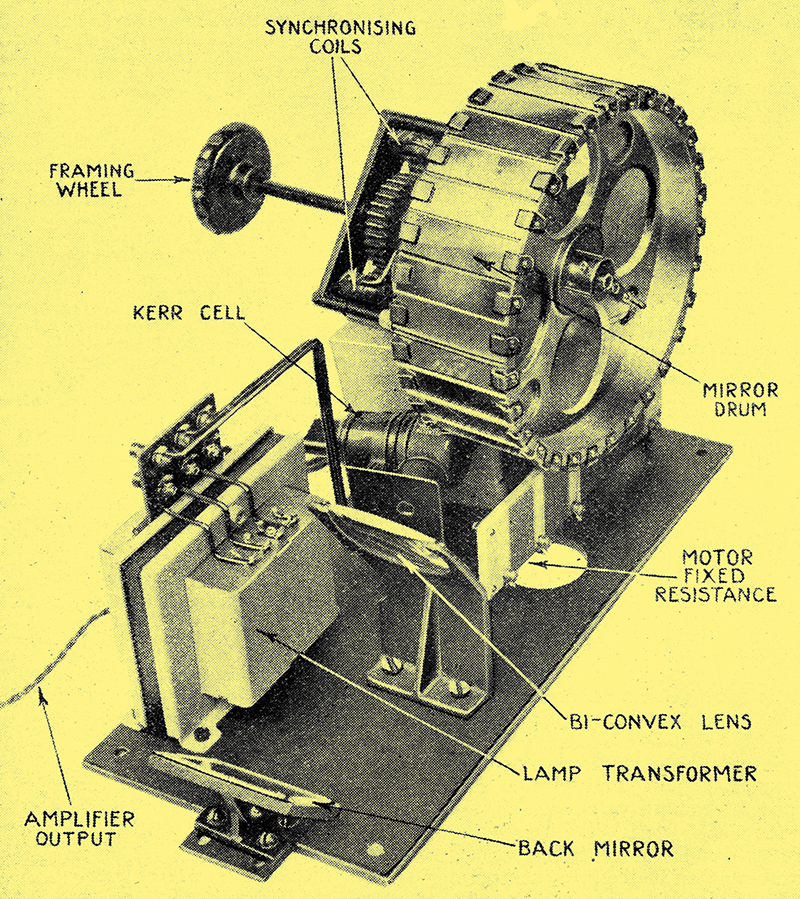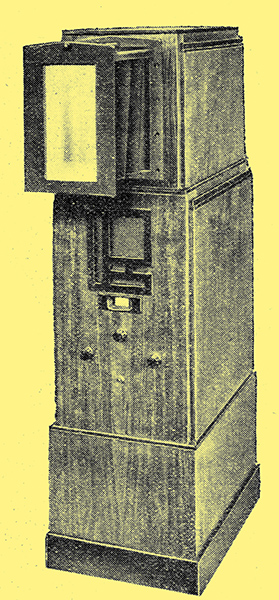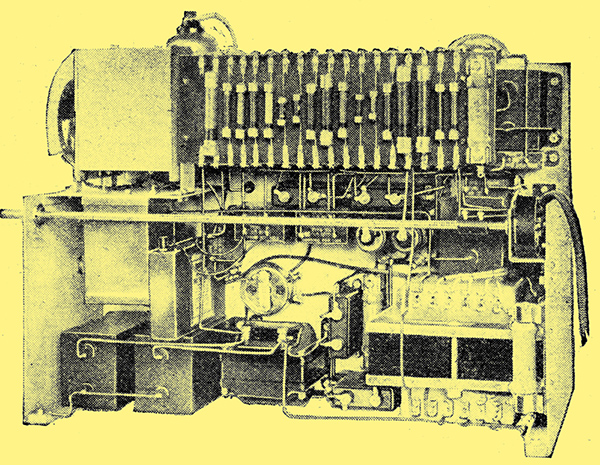|
An efficient mirror-drum televisor.

The important parts of the Baird projector. The rotary mirror drum works in conjunction with an optical system of adjustable lenses and mirrors.
Television transmission and reception has not yet achieved the degree of perfection which is now found in sound broadcasting, but in spite of this, the possession of a televisor is not without interest. Comparisons between vision and sound are difficult, but it is probable that the results now obtainable from good television apparatus are comparable with those given by sound equipment in the days when the weekly broadcast transmissions from Writtle were an outstanding event.
Unlike sound broadcasting, television receivers must be designed to operate with a given system of transmission, and the transmitter and the receiver are far more closely interlinked. The present BBC broadcasting is carried out on the 30 line, 12½ picture system, which means that 12½ complete pictures are transmitted each second, and that each picture is analysed by scanning it vertically 30 times. With the definition obtainable in this way it is probable that a receiver employing a mirror-drum is as satisfactory as any.

The picture covers the full area of the screen, 9 × 4 inches. The screen draws out to the correct position.
The apparatus under review is contained in a strongly built cabinet, which is similar in shape to that of a miniature grandfather clock, the lower portion contains the receiver proper, the power amplifier, and the mains equipment, while the upper part houses the purely television apparatus. The receiver is of conventional type, including HF amplification and resistance-capacity coupled LF circuits, and unusual care has been taken to avoid any loss of the upper modulation frequencies. Used for sound reproduction, therefore, the apparatus is capable of giving an exceptionally high standard of quality. Tuning coils are included for the medium waveband only, since there are no television transmissions on the long wave-band. A loud speaker is fitted in order to facilitate tuning, and when the station has been found a switch permits a change over to the television equipment.
The output valve is of the 25 Watt type and feeds a Baird Grid Cell which acts to convert current, or, more strictly speaking, potential variations, into variations of light intensity. An additional valve of similar type is provided for synchronising, and it is doubtless largely due to the considerable power which it supplies that such a good performance is obtainable.
The Television Equipment
The Baird Grid Cell acts, as a loud speaker in sound reception, to convert the electrical impulses into a form in which they can be detected by the senses. it consists essentially of a type of Kerr cell mounted between Nicol Prisms. A 100 Watt lamp is mounted at one end of the assembly, and in its passage through the prisms and cell the light is modulated by the varying electrical potentials on the plates of the Kerr cell. The cell itself is a voltage-operated device, so that at first it seems that a large power valve is unnecessary for its control. Owing to its high self-capacity, however, it must be shunted by a fairly low resistance if frequency and phase distortion are to be kept at a low value. In order to obtain the necessary voltage variations across this resistance quite a large amount of power is required.
The modulated light output of the cell falls upon the mirror drum from which it is reflected on to the viewing screen. The drum contains thirty flat mirrors, each set at a slightly different angle so that with the drum rotating at the correct speed and in the absence of a signal thirty vertical, parallel, and equi-spaced lines appear on the screen. This screen must be at some considerable distance from the mirror, so that to obtain a compact assembly it is arranged with bellows to pull out of the cabinet when reception is required.
The drum is driven by an electric motor, the speed of which is controlled by a variable resistance mounted on the left-hand side of the cabinet with the motor switch and the framing control. To assist in obtaining the correct speed it is fitted with a stroboscopic indicator which is viewed by the light of a neon tube operated by the 50 Hz lighting supply. With the aid of this it is a simple matter to adjust the motor speed. When the motor gathers speed the lines of the stroboscope can be seen slowly rotating, and as the correct speed is approached the apparent rotation is reduced. When the correct speed is found the stroboscope lines appear stationary.
Synchronising is carried out in the usual way. The black edging provided at the transmitter gives a series of pulses, one at the top of each scanning line. Since there are thirty lines per picture and 12½ pictures a second, there are 375 synchronising impulses a second, and in the receiver these are applied to what is virtually a small motor mounted on the main drum driving shaft. If the main driving motor increases or decreases its speed, the synchronising control operates to give a breaking or accelerating effect and to maintain constant speed.
The controls comprise the normal tuning and volume adjustments, and an on-switch mounted on the front of the cabinet, together with a control which acts to bias the Grid Cell and so regulate the average illumination of the picture. At the side of the cabinet are the purely television controls ; the motor speed regulator, the framing handle, and the motor on-off switch, together with a viewing hole for the stroboscope.
Adjusting the Apparatus
In operation, the station is tuned in using the loud speaker as anb indicator. The motor is started up and adjusted to its correct speed by the rheostat while watching the stroboscope. A change over from the speaker to the vision equipment is then made, and if perfect synchronism has been obtained the picture will be visible. A 'flashing rain' effect indicates that the motor speed is incorrect, and an appropriate adjustment to the controlling resistance effects the necessary alteration.
When the picture appears, however, it may not be in frame; that is, it may be divided horizontally or vertically. This indicates incorrect phasing, and is adjusted by the framing control. This control operates to rotate the carcase of the motor and so moves the picture in a vertical direction. A small movement of this control, therefore, is sufficient to correct for any degree of vertical mis-framing. With most apparatus, horizontal mis-framing is more difficult to correct, and it is usually necessary to slow-up the motor momentarily so that a few pictures are slipped. The operation, therefore, requires some little skill for its successful accomplishment.
In this particular apparatus, however, the difficulty is avoided by a clever arrangement of the vertical framing control. The picture is arranged to be very slightly out of the vertical, so that rotating the carcase of the motor to produce a vertical displacement of the picture causes also a very slight sideways motion. To correct for horizontal displacement, therefore, it is necessary only to turn the framing control to a much greater degree than is necessary to compensate for vertical mis-framing. As the control is turned, the visual effect is of a number of pictures slowly moving vertically and gradually gliding sideways.
Performance
The operation, therefore, is quite simple, and the performance obtainable probably represents the best that can be achieved with the present 30-line transmissions. The detail obtainable is not high, and dark objects of different degrees of illumination tend to merge together. Thus, a manbs chin is quite distinct as long as his head is held upright, but it merges into his tie when he looks downwards and his chin falls into the shadow. The scanning lines are quite obvious, and give a vertical striped appearance to any white object, such as a shirt front.
In spite of these drawbacks, which are unavoidable with the present transmissions, the programme can be followed with ease provided that it does not contain too rapidly moving objects. The degree of definition is such that it is easily possible to recognise a well-known face.
The synchronising is really good, and during the half an hour's transmissions the apparatus often carries through without going out of synchronism even once. Occasional readjustment of the framing is necessary, since there is an occasional slow drift of the picture. The lapses from synchronism are apparently due more to the transmitter than to the receiver, for they invariably occur at the end of an item, when the curtain falls in the studio. Apparently this interrupts the synchronising impulses.
The apparatus is solidly built, and should give long and satisfactory service, and its adjustment does not call for any special degree of skill. The makers are Bush Radio, Ltd., of Woodger Road, Shepherd's Bush, London, W12, and the apparatus is priced at 50 guineas complete.

The amplifier and radio receiver unit.
|